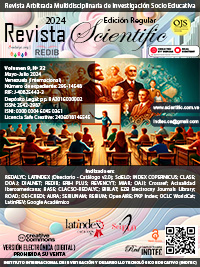Efecto postpandemia en la brecha digital generacional entre maestros y alumnos de la FCA
Post-pandemic effect on the generational digital gap between teachers and students of the FCA
DOI:
https://doi.org/10.29394/Scientific.issn.2542-2987.2024.9.32.8.169-188Palabras clave:
aprendizaje en línea, desarrollo de las habilidades, habilidad pedagógica, brecha digital, brecha generacionalResumen
La brecha tecnológica vinculada con el nivel digital innato de cada cohorte demeritaba el aprovechamiento de las Tecnologías de la Información y las Comunicaciones (TIC´s) en la gestión educativa. El objetivo de este estudio fue cuantificar el efecto que tuvo la pandemia por COVID-19 entre maestros y alumnos de nivel licenciatura de la Facultad de Contaduría y Administración (FCA) de la Universidad Autónoma de Chihuahua (UACH), respecto de la brecha digital generacional. La naturaleza de esta investigación fue cuantitativa, tipo aplicada, el alcance fue descriptivo, el modo fue de campo con apoyo bibliográfico, el diseño fue no experimental-longitudinal. Se aplicó un cuestionario en 2020 y 2023 a una muestra estratificada de docentes y estudiantes. Los resultados mostraron que el aprovechamiento personal de las TIC´s aumentó un 30% en docentes y 9% en alumnos después de la pandemia. En cuanto al uso de herramientas digitales para la formación, hubo un incremento del 10% en maestros, pero una disminución del 4% en alumnos. Se concluye que la pandemia impulsó el aprovechamiento de las TIC´s mayormente en docentes, reduciendo la brecha digital. Sería interesante estudiar si las habilidades blandas de las nuevas generaciones no favorecieron el incremento de competencias digitales durante la contingencia.
Descargas
Citas
Díaz, C., López, M., & Roncallo, L. (2017). Entendiendo las generaciones una revisión del concepto, clasificación y características distintivas de los Baby Boomers, X Y Millennials. Clío América, 11(22), 188-204, e-ISSN: 2389-7848. Colombia: Universidad del Magdalena.
Espiritusanto, O. (2016). Generación Z: Móviles, redes y contenido generado por el usuario. Revista de Estudios de Juventud, 8(114), 111-126, e-ISSN: 0211-4364. España: Injuve (Instituto de la Juventud).
Strauss, W., & Howe, N. (1991). Generations: The History of America´s Future, 1584-2069. New York, United States: William Morrow and Company.
Jardines, F. (2009). Desarrollo histórico de la educación a distancia. InnOvaciOnes de NegOciOs 6(2): 225-236, e-ISSN: 2007-1191. Recuperada de: https://doi.org/10.29105/rinn6.12-5
López, A. (2017). Proyecto de la Nación 2018-2024. México: Auditorio Nacional.
ONU (2023). Se acaba la emergencia por la pandemia, pero el COVID continua. Nueva York, Estados Unidos: Naciones Unidas.
UNESCO (2022). El derecho a la educación. París, Francia: Organización de las Naciones Unidas para la Educación, la Ciencia y la Cultura.
Pérez, J., & Gardey, A. (2017). Aprovechamiento. España: Definicion.de.
Prensky, M. (2001). Digital Natives, Digital Inmmigrants. On the Horizon, 9(5), 1-6. United Kingdom: MCB University Press.
Rozo-García, F. (2020). Revisión de las tecnologías presentes en la industria 4.0. Revista UIS Ingenierías, 19(2), 117-192, e-ISSN: 2145 - 8456. Recuperado de: https://doi.org/10.18273/revuin.v19n2-2020019
Crovi, D. (2010a,b). Jóvenes, migraciones digitales y brecha tecnológica. Revista mexicana de ciencias políticas y sociales, 52(209), 119-133, e-ISSN: 0185-1918. México: Universidad Nacional Autónoma de México.
DOF (2020). Acuerdo número 14/07/20. México: Diario Oficial de la Federación.
Publicado
Cómo citar
Número
Sección
Licencia
Derechos de autor 2024 INDTEC, C.A.

Esta obra está bajo una licencia internacional Creative Commons Atribución-NoComercial-CompartirIgual 4.0.
El contenido de las revistas de este sitio, están bajo una Licencia de Creative Commons Reconocimiento-NoComercial-CompartirIgual 4.0 Internacional.













